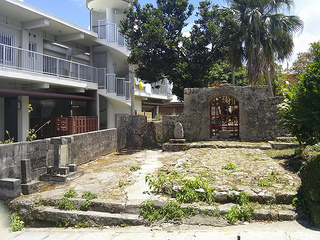Difference between revisions of "Adani-ga-daki"
(Created page with "right|thumb|320px|Adani-gaa-daki *''Japanese/Okinawan'': 安谷川嶽 ''(Adani gaa daki)'' Adani-gaa-daki is an Okinawan ''utaki'', or sacred place, as...") |
|||
| Line 2: | Line 2: | ||
*''Japanese/Okinawan'': 安谷川嶽 ''(Adani gaa daki)'' | *''Japanese/Okinawan'': 安谷川嶽 ''(Adani gaa daki)'' | ||
| − | Adani-gaa-daki is an Okinawan ''[[utaki]]'', or sacred place, associated with [[Oamushirare|Ôamushirare]]<!--大阿母志良礼・うふ あむしられ-->, a high-ranking high priestess of the [[Ryukyu Kingdom|Ryûkyû Kingdom]]. | + | Adani-gaa-daki is an Okinawan ''[[utaki]]'', or sacred place, associated with the nearby Adani-gaa natural water spring. It also bore a connection to the [[Oamushirare|Ôamushirare]]<!--大阿母志良礼・うふ あむしられ-->, a high-ranking high priestess of the [[Ryukyu Kingdom|Ryûkyû Kingdom]]. |
| − | The site is located | + | The site is located in the Tônokura neighborhood of [[Shuri]], along the old ''[[shuku michi]]'' (post road) connecting Shuri and [[Urasoe]]. It features a stone gate separating the inner space from the outer space; within the inner space are located sacred stones, a stone circle, and the entrance to a small cave. |
Two stelae flank the entrance to the outer section of the space, where it is separated from the road. One stele, erected in [[1814]], attests that the residents of Tônokura contributed to form a fund to maintain the site, while the other was erected after World War II, when the site was restored. The site was named a Tangible Folk Cultural Asset by the city of [[Naha]] in 1977. | Two stelae flank the entrance to the outer section of the space, where it is separated from the road. One stele, erected in [[1814]], attests that the residents of Tônokura contributed to form a fund to maintain the site, while the other was erected after World War II, when the site was restored. The site was named a Tangible Folk Cultural Asset by the city of [[Naha]] in 1977. | ||
| Line 11: | Line 11: | ||
==References== | ==References== | ||
| − | *Plaques on-site. | + | *Plaques on-site at Adani-gaa, and at Adani-gaa-daki. |
==External Links== | ==External Links== | ||
*[https://maps.google.com/maps?q=%E5%BD%93%E8%94%B5%E7%94%BA%EF%BC%91%E4%B8%81%E7%9B%AE&hl=en&ie=UTF8&ll=26.221747,127.718116&spn=0.000582,0.002642&sll=37.0625,-95.677068&sspn=37.052328,86.572266&t=h&hq=%E5%BD%93%E8%94%B5%E7%94%BA%EF%BC%91%E4%B8%81%E7%9B%AE&radius=15000&z=19&layer=c&cbll=26.221747,127.718117&panoid=_7gf_AC8evR9Pgdy8b8rgg&cbp=11,108.9,,0,1.9 Adani-gaa-daki on Google Maps] | *[https://maps.google.com/maps?q=%E5%BD%93%E8%94%B5%E7%94%BA%EF%BC%91%E4%B8%81%E7%9B%AE&hl=en&ie=UTF8&ll=26.221747,127.718116&spn=0.000582,0.002642&sll=37.0625,-95.677068&sspn=37.052328,86.572266&t=h&hq=%E5%BD%93%E8%94%B5%E7%94%BA%EF%BC%91%E4%B8%81%E7%9B%AE&radius=15000&z=19&layer=c&cbll=26.221747,127.718117&panoid=_7gf_AC8evR9Pgdy8b8rgg&cbp=11,108.9,,0,1.9 Adani-gaa-daki on Google Maps] | ||
| + | *[https://maps.google.com/maps?q=%E5%BD%93%E8%94%B5%E7%94%BA%EF%BC%91%E4%B8%81%E7%9B%AE&hl=en&ie=UTF8&ll=26.222382,127.717907&spn=0.000582,0.002642&sll=37.0625,-95.677068&sspn=37.052328,86.572266&t=h&hq=%E5%BD%93%E8%94%B5%E7%94%BA%EF%BC%91%E4%B8%81%E7%9B%AE&radius=15000&layer=c&cbll=26.222383,127.717907&panoid=7JElgkXqq8wEmUtarr2Iug&cbp=11,269.26,,0,16.98&z=19 Adani-gaa spring on Google Maps] | ||
[[Category:Ryukyu]] | [[Category:Ryukyu]] | ||
[[Category:Edo Period]] | [[Category:Edo Period]] | ||
[[Category:Shrines]] | [[Category:Shrines]] | ||
Revision as of 07:31, 10 August 2013
- Japanese/Okinawan: 安谷川嶽 (Adani gaa daki)
Adani-gaa-daki is an Okinawan utaki, or sacred place, associated with the nearby Adani-gaa natural water spring. It also bore a connection to the Ôamushirare, a high-ranking high priestess of the Ryûkyû Kingdom.
The site is located in the Tônokura neighborhood of Shuri, along the old shuku michi (post road) connecting Shuri and Urasoe. It features a stone gate separating the inner space from the outer space; within the inner space are located sacred stones, a stone circle, and the entrance to a small cave.
Two stelae flank the entrance to the outer section of the space, where it is separated from the road. One stele, erected in 1814, attests that the residents of Tônokura contributed to form a fund to maintain the site, while the other was erected after World War II, when the site was restored. The site was named a Tangible Folk Cultural Asset by the city of Naha in 1977.
References
- Plaques on-site at Adani-gaa, and at Adani-gaa-daki.
